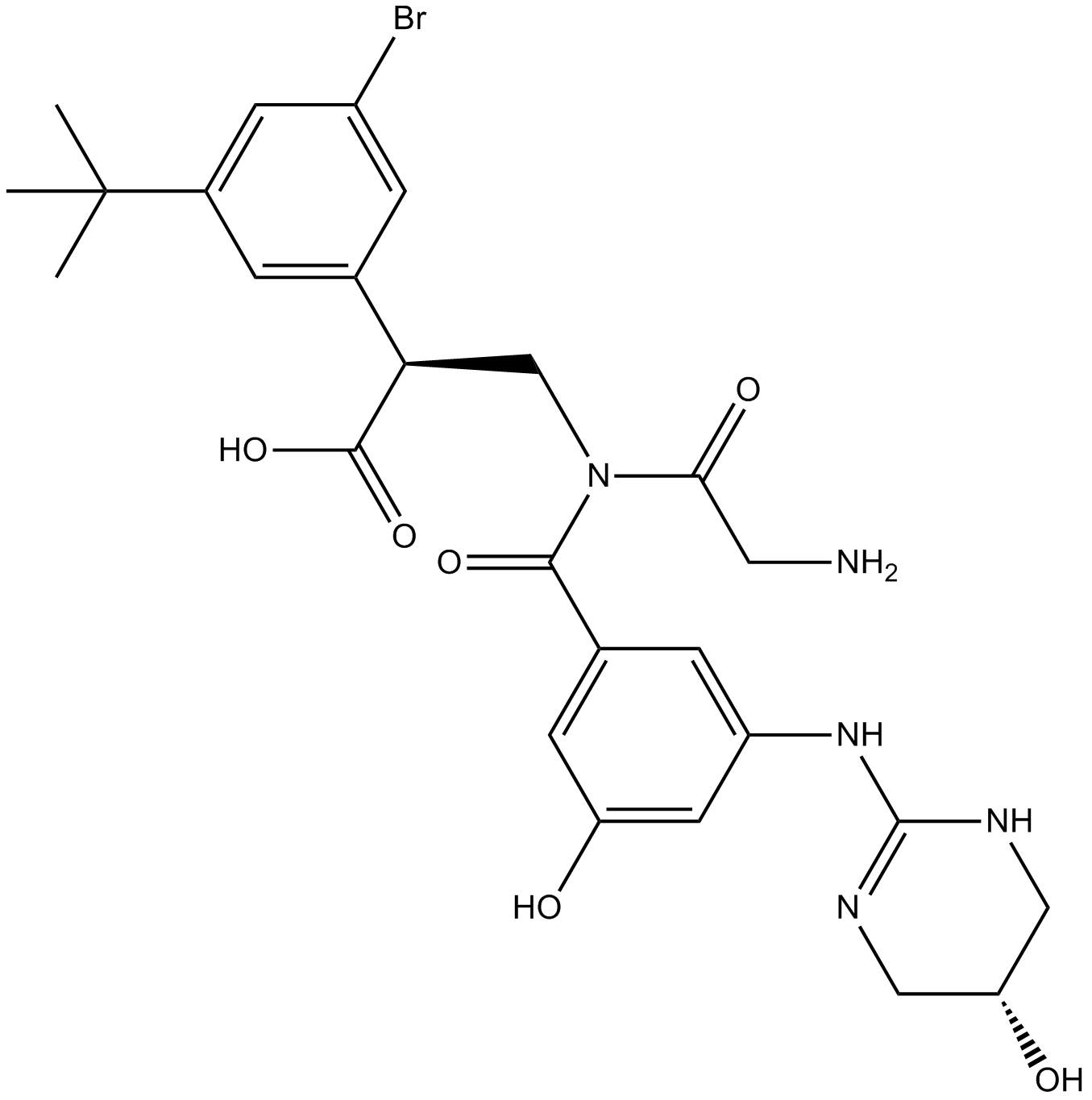|
Kinase experiment:
|
Functions of integrins αvβ1, αvβ8, α2β1 and α10β1 are measured using cell-free receptor-ligand interaction assays using purified recombinant human integrins. Ligands used are human fibronectin for αvβ1, human LAP for αvβ8, bovine collagen II for α2β1, and murine laminin I for α10β1. 96-well plates are coated with the predetermined optimal concentration of ligand overnight, washed 3X with TBS+++ (25 mM Tris pH7.4, 137 mM NaCl, 2.7 mM KCl, 1 mM MgCl2, 1 mM MnCl2, 1mM CaCl2), and blocked with TBS+++/1%BSA. Purified integrin is diluted in TBS+++/0.1%BSA with or without compounds (e.g., CWHM-12), and the solution added to empty wells of the washed ligand-coated plate according to a standard template, with each sample repeated in triplicate. After incubation for 2 hr at room temperature, the plate is washed 3X with TBS+++. Biotin-labeled antibody against the αv subunit (αvβ1, αvβ8 assays) or β1 subunit (α2β1, α10β1 assays) is applied for 1 hr. The plate is washed 3X with TBS/0.1%BSA. Streptavidin-conjugated horseradish peroxidase is added to the wells, and the plate incubated for 20 min at room temperature. Following a 3X TBS+++ wash, bound integrin is detected using streptavidin-conjugated horseradish peroxidase and TMB substrate with absorbance measured at 650 nm. For assay of αIIbβ3 (IIbIIIa) function, plates are coated with the purified human integrin overnight, washed 3X with TBS+++, and blocked with TBS+++/1%BSA. Alexa Fluor647-labeled purified human fibrinogen is diluted in TBS+++/0.1%BSA with or without compounds, and the solutions are added to the integrin-coated plate. After 2 hr incubation, the plate is washed 3X with TBS+++, and bound ligand is detected by absorbance measured at 640/668nm. For all assays, concentration-response curves are constructed by non-linear regression analysis and IC50 values are calculated using GraphPad Prism software[1].
|
|
Cell experiment:
|
The stably transfected human 293 cells over-expressing human αvβ3 or αvβ5 are pre-incubated in HBSS buffer containing 200 μM MnCl2 for 30 min at 37°C with 3-fold dilutions of compound (e.g., CWHM-12). Each sample is then added to triplicate wells of a 96-well plate which has been coated overnight at 4°C with a predetermined optimal concentration of purified vitronectin, washed, blocked by 1 hr incubation with BSA, and washed again. Cells are allowed to attach for 30 min at 37°C, and non-adherent cells are removed by washing. Remaining attached cells are measured by endogenous alkaline phosphatase activity using para-nitrophenyl phosphate and reading absorbance signal at 405 nM. The same procedure is used to measure adhesion of αvβ6-expressing human HT-29 cells to purified human latency associated peptide, and α5β1-expressing human K562 cells to human plasma fibronectin. In all cell-based assays, binding by the expected integrin is verified by testing activity of corresponding isotype-matched positive (function-blocking) and negative control antibodies[1].
|
|
Animal experiment:
|
Mice[1] The mTmG (Td tomato/EGFP) and Ai14 (Rosa-CAG-LSL-tdTomato-WPRE) mice are used and crossed with Pdgfrb-Cre mice. Wild type C57/BL6 mice, Itgavflox/flox mice and itgb8flox/flox mice are used. Mice used for all experiments are 8-12 weeks old and are housed under specific pathogen-free conditions. For all studies CWHM-12 and CWHM-96 are solubilized in 50% DMSO (in sterile water) and dosed to 100 mg/kg/day. Drug or vehicle (50% DMSO) are delivered by implantable ALZET osmotic minipumps. For CCl4-induced fibrosis, pumps are inserted subcutaneously either before the first dose of CCl4 (prophylactic) or after 3 weeks of treatment (therapeutic) and livers are harvested after 6 weeks. For Bleomycin-induced fibrosis pumps are inserted 14 days after treatment with Bleomycin or saline and lungs are harvested at 28 days (therapeutic only).
|





















